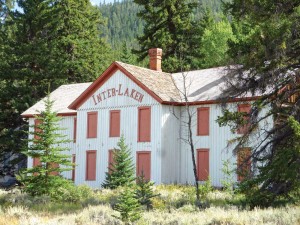by Virginia McConnell Simmons

Although few places in Colorado have finer scenery than the conjoined Twin Lakes, the fortunes of this hamlet have ebbed and flowed, just as the water levels of the lakes has. Originally, these natural glacial lakes consisted of conjoined bodies of water, one about two and one-half miles in length by one and one-half in width and the other half that size. Today the acreage of the lower lake is changed, due to a 135-foot-high dam, with seasonal water levels increasing and decreasing and with daily injections from a forebay above and a power plant below on the lower lake.
A mining camp called Dayton once existed on the north side of Upper Twin Lake in the mid-1860s and briefly served as the county seat of Lake County. The best-known visitors during the next years were Hayden’s and Wheeler’s geological surveys that camped at the lakes, along with William H. Jackson, who made one of his fine images there. By 1879 Dayton was overshadowed by the newer, nearby village of Twin Lakes, which became a destination for recreational visitors from Leadville, less than 20 miles away. Discoveries across Independence Pass at Aspen also brought pack trains, stagecoaches and wagons through Twin Lakes.
With its mines, Leadville had exploded into the second -largest city in Colorado. For holidays, the population of the “Cloud City” gratefully escaped the smoke and grit of Leadville for a “constant round of church and society picnics and private pleasure parties coming down to the lakes from Leadville,” as recounted in Health, Wealth, and Pleasure in Colorado and New Mexico (printed by the Denver and Rio Grande Railroad in 1881 and reprinted in 1980 by the Museum of New Mexico Press).
Twin Lakes for a while offered eight hotels of various quality such as the Twin Lake Hotel, plus camping, fishing and boating in summer, ice-skating in winter, and health benefits year-around, although, alas, the water was too cold for swimming. When the narrow gauge D&RG line arrived, afterward followed by the standard gauge Colorado Midland Railway, transportation for vacationers from Denver, Colorado Springs and farther away became enticing in summer. Pleasure seekers disembarked at Granite and rode in carriages up to Twin Lakes.

The best known of the hotels was the Inter-Laken on the south side of the lower lake. Built in 1879, John Statley and Charles Thomas called it the Lakeside Resort. James V. Dexter bought the property in 1883, renaming it the Inter-Laken Hotel, and set about developing it into a premier resort; he also constructed a charming summer home near the hotel. When the lake was enlarged in the 1980s, this group of deteriorating buildings was moved uphill about 150 feet by the Bureau of Reclamation but can still be visited on foot, bike, skis or by boat. These structures are in the National Register of Historic Places and have been stabilized, but Dexter House alone has remained suitable for restoration.
In its prime, Inter-Laken consisted of a two-story building, with an annex that served as a dance hall, a unique hexagon-shaped privy with leather seats, laundry, ice house, stable, granaries, and chicken and cows to provide fresh food. Discriminating guests dined on fine cuisine, and for recreation they enjoyed billiards, croquet, ballroom dancing and, of course, trout fishing and boating at the doorstep.
Dexter was a former mine surveyor and promoter with a fondness for playing poker and for hunting.(He had another home in Leadville, called Dexter Cabin, which has been preserved by the Colorado Historical Society and is open to visitors.) After Dexter’s death in 1899, Inter-Laken’s popularity declined until it eventually closed, but his name is remembered today at the Dexter Point boat ramp and campground across the lake.
Othermemorable resorts were the Evergreen and Idlewild Lodge, which Dexter acquired in the 1890s. Two excursion boats, The Idlewild and The Dauntless, ensured that a good time was had by all.
Surpassing these as a showplace, John F. Campion built a private summer home in 1895. Having made a fortune by investing in Leadville’s mines, particularly in the Little Jonny and Ibex properties, Campion became a leader in Colorado’s financial affairs. He invested in the sugar beet industry in eastern Colorado, among other businesses, and owned a mansion in Denver. His villa at Twin Lakes was large enough to accommodate a bowling alley and had an electric power plant at the narrows between the lakes. After his death in 1916, his lavishly appointed property became a hotel and later burned.
With the passing years, not surprisingly, water developers had an eye on Twin Lakes, which evolved as part of a vast plumbing system, the Fryingpan-Arkansas Project.
This undertaking started with water diversion from the Western Slope through a former Colorado Midland tunnel to Turquoise Lake west of Leadville and then down the Arkansas River. Following an agreement with Roaring Fork Water Users, confirmed in 1933, the Twin Lakes Reservoir and Canal Company built a tunnel under Independence Pass to Lake Creek, calling it the Transmountain Diversion System. In the mid-1930s, the Reservoir and Canal Company also built a dam to impound water to send down the Arkansas River to its customers in southeastern Colorado’s farm country.
In the late 1970s and early 1980s, the U.S. Bureau of Reclamation built the present enlarged dam and began bringing water from Turquoise Lake through a conduit to a forebay above Twin Lakes. From this forebay, water flows down to a power plant for hydroelectric generation, then back up and down repeatedly, filling the needs of water users. Meanwhile, southeastern Colorado’s agricultural water rights have been sold to Front Range municipalities.
But a relic, the Inter-Laken, can still be seen in its altered location, and fishermen, boaters and campers still enjoy visiting the Twin Lakes and the village bearing their name.
Virginia McConnell Simmons is the author of The Upper Arkansas: A Mountain River Valley and other books about Colorado and the American West.


